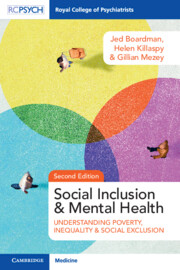Book contents
- Social Inclusion and Mental Health
- Reviews
- Social Inclusion and Mental Health
- Copyright page
- Contents
- Foreword to Second Edition
- Foreword to First Edition (2010)
- Preface
- Acknowledgements
- Chapter 1 Introduction: Poor, Excluded, and Unequal
- Section 1 Social Exclusion, Poverty, and Inequality
- Chapter 2 Social Exclusion: Basic Concepts
- Chapter 3 Social Exclusion: Applying the Paradigm to People with Mental Health Conditions – Key Aspects
- Chapter 4 Poverty and Deprivation: Getting Under the Skin
- Chapter 5 Poverty, Deprivation, and Social Exclusion in the United Kingdom
- Chapter 6 Poverty, Inequality, and Health
- Chapter 7 Social Policy, the Welfare State, and Social Exclusion
- Chapter 8 Mental Health Services and Policy in the United Kingdom
- Section 2 Participation of People with Mental Health Conditions
- Section 3 Including People
- Index
- References
Chapter 6 - Poverty, Inequality, and Health
from Section 1 - Social Exclusion, Poverty, and Inequality
Published online by Cambridge University Press: 24 November 2022
- Social Inclusion and Mental Health
- Reviews
- Social Inclusion and Mental Health
- Copyright page
- Contents
- Foreword to Second Edition
- Foreword to First Edition (2010)
- Preface
- Acknowledgements
- Chapter 1 Introduction: Poor, Excluded, and Unequal
- Section 1 Social Exclusion, Poverty, and Inequality
- Chapter 2 Social Exclusion: Basic Concepts
- Chapter 3 Social Exclusion: Applying the Paradigm to People with Mental Health Conditions – Key Aspects
- Chapter 4 Poverty and Deprivation: Getting Under the Skin
- Chapter 5 Poverty, Deprivation, and Social Exclusion in the United Kingdom
- Chapter 6 Poverty, Inequality, and Health
- Chapter 7 Social Policy, the Welfare State, and Social Exclusion
- Chapter 8 Mental Health Services and Policy in the United Kingdom
- Section 2 Participation of People with Mental Health Conditions
- Section 3 Including People
- Index
- References
Summary
This chapter examines the changes in economic inequalities in the UK and internationally along with the links between poverty and inequality. We outline the way in which health and illness are distributed in the population and the psychosocial factors that operate to create and maintain health inequalities. Poverty and economic inequality are intrinsically and instrumentally related. Both are relevant to deprivation, violate human dignity, hinder social and health goals, and fluctuate in populations in a correlated manner. Health and illness are socially patterned in the same way as we saw for the experience of poverty, and are related to social class and status. Health and ill-health are determined not only by biological mechanisms, but also by a series of upstream factors which are material, psychological, social, and political – that is, by the ‘causes of the causes’. The examination of poverty, economic inequality and health inequalities reveal psychological, social, economic, and political factors that can help us to develop a firmer understanding of the social exclusion of people with mental health conditions as well as important aspects of public mental health.
Keywords
- Type
- Chapter
- Information
- Social Inclusion and Mental HealthUnderstanding Poverty, Inequality and Social Exclusion, pp. 116 - 140Publisher: Cambridge University PressPrint publication year: 2022

